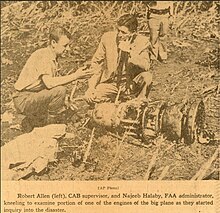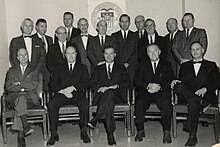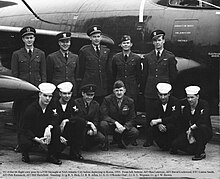Bobbie R. Allen
[2][3] Charles S. Murphy, adviser to three U.S. Presidents and Chairman of the Civil Aeronautics Board, nominated Allen for the Rockefeller Public Service Award and wrote the following: "His outstanding work has contributed significantly to the constantly improving safety record throughout the world."...Allen's father was an oil field laborer and shoe cobbler, and his mother was a waitress at a small restaurant near their home in Marshall, Texas.In June 1942, Allen was working part time at the Logan and Whaley Hardware Store when he graduated from Marshall High School."[15] By mid 1968, due to declining health, Allen had stepped down as Director, but continued efforts to overcome the industry’s reluctance to participate.After receiving this news, Allen would share the results with NTSB leadership and although they thought there would soon be acceptance, implementation would be stalled for years.After investigators learned that similar circumstances had occurred on a United Airlines flight just six weeks earlier a scramble ensued to overcome the public's outcry and in May 1975, the FAA announced the inauguration of a confidential, non-punitive incident reporting scheme.On Allen's last of five launches for the day, the ships catapult bridle failed, and his plane rolled forward, too fast to stop, and too slow to fly.[21][22] After returning to the states, Allen would remain on active duty until 1959, when he accepted an Aircraft Accident Investigation position with the Civil Aeronautics Board.Based at NAS Whidbey Island Washington, the squadron operated S2F Trackers patrolling waters off the Pacific Northwest coast, searching for Soviet submarines using airborne Anti-Submarine Warfare techniques until August 1962.







Bobbie Allen (disambiguation)Winnsboro, TexasFort Worth, TexasKilgore Jr. CollegeSt. Mary's CollegeNaval War CollegeUniversity of Southern CaliforniaCaptainWorld War IIKorean WarBerlin CrisisNational Transportation Safety Boardflight data recordersAviation Safety Reporting SystemCharles S. MurphyCivil Aeronautics BoardMarshall, TexasNajeeb HalabyWhite HouseSoviet UnionAlan S. BoydJerome F. LedererAirlines for AmericaTWA Flight 514Grumman F6FPacific theaterGrumman F6F HellcatUSS Roi (CVE-103)USS Saratoga (CV-3)USS Corregidor (CVE-58)USS Tripoli (CVE-64)USS Bon Homme Richard (CV-31)Douglas F3D SkyknightF3D SkyknightUSS Franklin D. Roosevelt (CV-42)empennageUSS Lake Champlain (CVA-39)Berlin Crisis of 1961Commanding OfficerNAS Whidbey IslandS2F TrackersAnti-Submarine WarfareAndrews Air Force BaseU.S. Naval War CollegeBoeing Stearman N2S KaydetVaultee SNV ValiantNorth American SNJ TexanCurtiss SC SeahawkDouglas R5D SkymasterDouglas R4D SkytrainVought F4U CorsairVought OS2U KingfisherGrumman F8F BearcatGrumman S2F TrackerMcDonnell F2H BansheeLockheed P2V-5F NeptuneLockheed TV-2 Shooting StarNavy Air MedalNational Def Service MedalKorean Service MedalWWII Victory MedalAmerican Campaign MedalAsiatic Pacific Campaign MedalChina Service MedalNaval Reserve MedalNavy Occupation Service MedalUnited Nations Korea MedalU.S. Navy Nurse CorpsVero Beach, FloridaMurphy, Charles S.Johnson, Lyndon B.Murphy, Charles SInternational Civil Aviation Organization